33 Large 925 SILVER SHOFAR Blow Horn STAR of DAVID + MENORAH Jerusalem 7 Branch



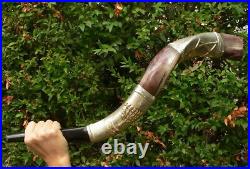




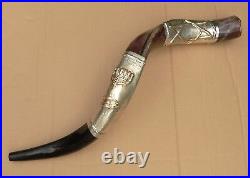
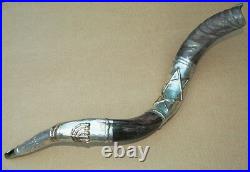
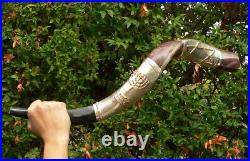

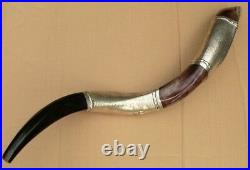

Silver Plated Large Kosher Jewish Shofa. Decorated with Biblical Jewish Symbols Star of David – Shield of king David, and Jerusalem Holy Temple 7 Branch Lamp Menorah. Blow the trumpets in Zion, And sound an alarm on my holy mountain! Let all the inhabitants of the land tremble, for the day of the LORD is coming. High Quality, Yemenite Kudu Shofar Blow Horn. Handcrafted, Plated 925 Sterling Silver. This is a Large Impressive Shofar, Approximate Size : 31 – 35 Inch / 79 – 89 cm. The Shofar is finely handcrafted and decorated with a thick copper sheet around, plated real 925 Sterling Silver, with hebrew biblical symbols, the Jewish Star of David Magen David hexagram, and lamp of eternity fire – Jerusalem temple Menorah Symbol. Embossed and colored in shiny Gold color. Magnificent for Display at home, and for special religious ceremonies, holidays, collectible, special gift. Please your patience – this Shofar is especially handmade per order and can. Each shofar is unique and special, we will make sure to pick the best one for you. The Shofar is Strong and durable, Authentic ancient Jewish Yemenite style – long & curved Shofar, hand made in Israel from high quality African Antelope Kudu horns. The horns are drilled, shaped and partly polished, showing the natural texture and original colors. All Shofars are cleaned and sterilized. Certified Kosher by the Israeli Chief Rabbinate. Each Shofar is handpicked and tested to ensure high quality. We also offer Shofar bags in different sizes. Made in Israel the Holy Land, crafted from African Kudu (Antelope) Horn, Silver Plated. Lovely for display and use, but you must must know how to blow, see “free” directions below. Approximate Size (Length) : 33 inch / 84 cm (Sizes will slightly vary from Shofar to Shofar). Length is measured on the circumference – from tip to tip – from the mouthpiece to the shofar’s “trumpet” opening. The Shofars come in assorted different colors and shapes, we cannot guarantee specific color. Since it is organic animal horn they vary in shape and color. We handpick, carefully examining and inspecting each Shofar, to make sure you get the best quality! Authentic Judaica gift from Israel, the Shofar is nice for display and for use, usually we blow the horn around the Jewish new year, when people are soul seeking and praying for answers and forgiveness. It is a great Mitzvah to hear the Shofar blows at synagogues at Rosh Hashanah and Yom Kippur (the high Jewish holidays), and take our prayers high and through the doors of the sky, to be heard and answered, and hopefully fulfilled. Liorel Art from Israel. Directions for blowing the Shofar : Hold the Shofar up with the mouthpiece flat (horizontal), usually against the SIDE of your mouth. The lips should be straight and sealed – and only the little part that is covered by the Shofar’s mouthpiece should “tremble” apart, when blowing HARD through the shofar. It is a bit like a long continuous spitting from the side of your mouth. Try holding your lips tight with your fingers and let air blow through the side – the trembling lips make the sound, and the horn amplifies it OUT LOUD (Btw the Australian Didgeridoo works on the same idea). Blowing long and clear blows takes some good practice and patience, but once you get the idea, it is very easy and enjoyable (of course if your neighbors don’t mind). Directions for storage and cleaning : store in a cool and dry, breatheable place. Clean Silver plating periodically for shine and glow with a dry towel or special materials for silver, The shofar is a live tissue (bit like nails). Using wax, detergents, solvents etc will harm it. Traditional ram’s horn shofars are made from the horns of sheep while Yemenite shofars are made from the horns of kudu antelope. Kudu are found almost exclusively in eastern and southern Africa. These true horns, unlike the antlers of deer, have a bony core that is actually an extension of one of the bones of the animal’s skull. The specialized layer of skin that covers this core of bone contains the protein keratin that makes the horn, and later the shofar, extremely tough and durable. No two animal horns look alike and no two shofars sound exactly the same. As the ram and kudu grow older, their horns get larger and become more and more twisted into a curve or even a spiral, especially with rams. Horns of older rams often form two or three complete loops. Larger ram’s horn shofars are rare and more difficult to get nowadays. More on the shofar: A shofar is a horn. Traditionally that of a ram. Shofar-blowing is incorporated in syna. Shofars come in a variety of sizes. Bible and rabbinic literature. Is mentioned frequently in the. The blast of a shofar emanating from the thick cloud on. Tremble in awe (Exodus 19:16). Shofar (by Alphonse Lévy) Caption says: “To a good year”. The shofar was used to announce holidays Ps. 4, and the Jubilee year. The first day of the seventh month Tishri. Is termed “a memorial of blowing” Lev. 23:24, or “a day of blowing” Num. 29:1, the shofar. They were for signifying the start of a war Josh. 6:4; Judges 3:27; 7:16, 20; I Sam. Later, it was also employed in processions II Sam. 6:15; I Chron. 15:28, as musical accompaniment Ps. 47:5 and eventually it was inserted into the temple orchestra by David Ps. Note that the’trumpets’ described in Numbers 10 are a different instrument, described by the Hebrew word’trumpet’ Hebrew. Hasosrah, not the word for shofar Hebrew. Describes the first day of the seventh month (1st of Tishri = Rosh ha-Shanah) as a zikron teru? Ah memorial of blowing; Lev. Xxiii and as a yom teru? Ah ; day of blowing; Num. This was interpreted by the Jewish sages as referring to the sounding of the shofar. In the Temple in Jerusalem. The shofar was sometimes used together with the trumpet. On New Year’s Day the principal ceremony was conducted with the shofar, which instrument was placed in the center with a trumpet on either side; it was the horn of a wild goat. And straight in shape, being ornamented with gold at the mouthpiece. On fast days the principal ceremony was conducted with the trumpets in the center and with a shofar on either side. On those occasions the shofarot were rams’ horns. Curved in shape and ornamented with silver at the mouthpieces. On Yom Kippur of the jubilee year. The ceremony was performed with the shofar as on New Year’s Day. On Rosh Hashanah and other full holidays Day of Atonement, Ingathering of the harvest Sukkot. , Passover and the Feast of Weeks – Pentecost a single Priest perfected two sacrifices in honor of the full holiday, (Note that festivals such as Hanukah and Purim, are not considered full holidays requiring an extra sacrifice). On Rosh Hashanah, something special occurred during the special sacrifice. Arguably two Shofar Sounders played the long notes and one Trumpet player played the short note. Accordingly, Rosh HaShanah is called Yom Teruah (the day of the blast) Otherwise, the Trumpets had top billing. ” Rosh Hashanah27a, supports this claim: “Said Raba or it may have been R. Levi: What is the scriptural warrant for this? – Because it is written, With trumpets and the sound of the Shofar shout ye before the King in the Temple, we require trumpets and the sound of the Shofar; elsewhere not. Indeed, on Yom Kippur, the Shofar was sounded to announce the Jubilee Year. Every 50 years, Jews were granted forgiveness, debts were forgiven, indentured Israelites were granted freedom, and the fields shall become owned by the priests. Shofar first indicated in Yovel Jubilee Year – Lev. Indeed, in Rosh Hashanah 33b, the sages ask why the Shofar sounded in Jubilee year. Further support is found in Rosh Hashanah 29a, where the Talmud talks of trumpets for sacrifices but Shofar in the Jubilee Year does not apply to priests who are exempt from the obligations of the jubilee. Perhaps, we have the first mention of Shofar Sounding by non-Priests. Perhaps the first distancing away from the Sacrificial Cult. Otherwise, for all other special days, the Shofar is sounded shorter and two special silver Trumpets announced the sacrifice. When the trumpets sound the signal, all the people who were within the sacrifice prostrate themselves, stretching out flat, face down and on the ground. The shofar was blown in the times of Joshua. To help him capture Jericho. As they surrounded the walls, the shofar was blown and the Jews were able to capture the city. The shofar was commonly taken out to war so the troops would know when a battle would begin. The person who would blow the shofar would call out to the troops from atop a hill. All of the troops were able to hear the call of the shofar from their position because of its distinct sound. Times, the shofar was enhanced in its religious use because of the ban on playing musical instruments as a sign of mourning for the destruction of the temple. It is noted that a full orchestra played in the temple. The shofar continues to announce the New Year. And the new moon,, to introduce Shabbat. To carry out the commandment to sound it on Rosh Hashanah, and to mark the end of the day of fasting on Yom Kippur once the services have completed in the evening. Secular uses have been discarded see a notable exception in a section further down. The shofar is primarily associated with Rosh Hashanah. Indeed, Rosh Hashanah is called “Yom T’ruah” (or “Yom Teruah”) (the day of the shofar blast). Book of early rabbinic laws derived from the Torah. , a discussion centers on the centrality of the shofar in the time before the destruction of the second temple (70 AD). Indeed, the shofar was the center of the ceremony, with two silver trumpets playing a lesser role. On other solemn holidays, fasts, and new moon celebrations, two silver trumpets were featured, with one shofar playing a lesser role. The shofar is also associated with the jubilee year. In which, every fifty years, Jewish law provided for the release of all slaves, land, and debts. The sound of the shofar on Rosh Hashanah announced the jubilee year, and the sound of the shofar on Yom Kippur proclaimed the actual release of financial encumbrances. (Jewish law) rules that the shofar may not be sounded on Shabbat due to the potential that the ba’al tekiyah (shofar sounder) may inadvertently carry it which is in a class of forbidden Shabbat work. The historical explanation is that in ancient Israel, the shofar was sounded on Shabbat in the temple located in Jerusalem. After the temple’s destruction, the sounding of the shofar on Shabbat was restricted to the place where the great Sanhedrin. Jewish legislature and court from 400 BCE to 100 C. However, when the Sanhedrin ceased to exist, the sounding of the shofar on Shabbat was discontinued. The shofar says, Awake, sleepers from your sleep, and slumberers arise from your slumber! Mishneh Torah, Laws of Repentance 3:4. The Sages indicated that the mitzvah. Was to hear the sounds of the shofar. They went so far as to consider a shofar blown into a pit or cave and to decide whether a person who hears the original sound or the echo has fulfilled the mitzvah. Mishnah (Rosh Hashanah 27b). The Shulchan Aruch sums up that if the hearer hears the reverberation, the mitzvah is not valid. However, if the listener perceives the direct sounds, he fulfils the mitzvah. Thus, most modern halakhic authorities hold that hearing a shofar on the radio or the Internet would not be valid to satisfy the mitzvah because electronically reproduced sounds do not suffice for mitzvot that require hearing a specific natural sound. However, one should consult a competent rabbi if an unusually pressing situation arises, as some authorities believe that performing mitzvot through electronically reproduced sound is preferable to not performing them at all. According to Jewish law. Women and minors are exempt from the commandment of hearing the shofar blown (as is the case with any positive, time-bound commandment), but they are encouraged to attend the ceremony. If the Baal Tekiyah (shofar sounder) blows with the intention that all who hear will perform the mitzvah, then anyone listening-even someone passing by-who intends to hear the Shofar can perform the mitzvah because the community blower blows for everybody. If the listener stands still, it is presumed he intends to hear. If one hears the blast but with no intention of fulfilling the mitzvah, then the mitzvah has not been fulfilled. The expert who blows (or “blasts” or “sounds”) the shofar is termed the Tokea lit. “Blaster” or Ba’al T’qiah lit. “Master of the Blast”. Being a Ba’al T’qiah (shofar sounder) is an honor. Every male Jew is eligible for this sacred office, providing he is acceptable to the congregation. The one who blows the shofar on Rosh Hashanah. Should likewise be learned in the Torah and shall be God-fearing; the best man available. If a potential choice will cause dissension, he should withdraw his candidacy, even if the improper person will be chosen. If a blind blower was dismissed, but the community did not find a blower as proficient, he should be appointed as community blower. The Shulchan Aruch discusses who is fit to blow the shofar on behalf of a congregation. Anyone not obligated to fulfill the mitzvah of sounding the shofar cannot fulfill the commandment for (cover) another whose duty it is to perform the mitzvah. Although a woman (who is exempt from this mitzvah because it is time bound) may not blow the shofar for men (whose duty it is to perform the mitzvah), a female Ba’alat T’qiah may intone the shofar for herself and other women. Similarly, she may say a blessing over the mitzvah even though it is not mandatory the requisite blessing contains the words “asher kid’shanu b’mitzvotav v’tzivanu”, who sanctified us with His commandments [mitzvot] and commanded us to… , but women are not commanded in this mitzvah. Only a freeman (not even a slave who will become free in the next month) can be a Ba’al T’qiah. The Ba’al T’qiah shall abstain from anything that may cause ritual contamination for three days prior to Rosh Hashanah. Find a special gift Unique art works & gifts, handmade by Israeli artists Vintage antiques & collectibles from the early days of Israel. We are a small team dedicated to your service and always want to make sure that you are happy. If you’re not satisfied – we’re not satisfied. All orders are insured for loss or damage. Wrapping and packing are done with great care, to ensure safe arrival of the goods. We appreciate your help and patience. When contacting us please mark “I have a question about item”. If you need more time please let us know in advance. Thank you for visiting! Words : Jewish praying synagogue Ashkenazi Sefardi Sefaradi prayer service temple minyan Shaharit Mincha Minkha. Arvith Arvit succot succoth Sukkot Sukot Shavuos shavuot shavuoth pessach Pessah pesach pesah pasach. Passover Yom Kippur Kipur atonement days yamim noraim new year rosh hashanah. Hashana Judaica Shabbat Shabat Sabbath Judaism jew. Words : synagogue prayer service temple minyan Shaharit Mincha Minkha. Maariv Arvith Arvit succot succoth shavuot shavuoth pessach pesach pasach. Passover Yom Kippur Kipur rosh hashanah Related subjects: Zion, Judaism, religious, religion, holy script, Hebrew, sifrei kodesh, jewish, jew, jews, Judaism, bible, seforin, sefarim, kodesh book, old, antique,, halacha,, halakha, rabbi, rabbinic. Juif, juive, juden, Judisch, Judische, Bucher, Ebreo, Hebraica, Hebreo, Art, Artist, Artistic, Artists, Illustration, Illustrato, haebraische, judaika, judio, Shabbat Kodesh Sabbath Blessing Sabath times Sabat kabbalat Shabbos Shabos Shabbes Mezuzah case parchment Shema Yisrael Shma Israel kosher Tanakh Tnach Torah bible Gvil Ashkenazi Sephardi Sepharadic Beit Yosef Ari Jewish Judaica Hebräisch Hebrew psalms judisch Judisches Jew Mitzvah Rabbi Blessing Holy Shabes Kabalat Shabbas Shabat candles Chabbat Kiddush Chabat koddesh Schabbat Schabbos Schabes judisch Mitzvah jew Blessing Jewish festival holiday Passover table Spring festival Pesach Pesah Israelites Israeli 12 tribes of Israel Pessach ten commandments Bnei yisrael people of Israel tables of the covenant Tradition Religion Ritual Mitzvah Torah Shalom Israeli Hebrew calendar Shofar Ram horn Praying Prayer Tefila Synagogue Beit Knesset biblical Bible Mishnah Halakha Halacha Torah Tanakh Yiddish Siddur, Holy Temple in Jerusalem, Beit Ha-Mikdash. High Holidays, Sukot Sukkot Yom Kippur Beit Ha-Mikdash, hasidic Ashkenaz, ashkenazic judaism Holy Land Canaan. Yerushalayim, yerushalem, yerushalaim Torah Tora bible bilical. This item is in the category “Collectibles\Religion & Spirituality\Judaism\Shofars”. The seller is “artfromisrael” and is located in this country: IL. This item can be shipped worldwide.
- Origin: holy land jerusalem israel
- For use in: Synagogue, church prayer religious ceremony
- Animal: Kudu large african antelope
- Handmade: Yes
- Ritual Object: collectible shofarot rare shofar authentic judaica
- Country/Region of Manufacture: Israel
- Religion: judaica judaism christian messianic evangelist
- Size – Length: large big size 31-35 Inch / 79-88 cm
- jewish holidays: Jewish New year, Rosh Hashanah, atonement day
- Country of Manufacture: handmade in Israel
- Plating: 925 Sterling Silver, with gold color
- Design: Magen shield of Israel, king David, Menorah
- Shofar Type: Yemenite Kudu Blow Horn, Jewish Shofar
- christian holidays: feast of tabernacles trumpets easter christmas
- 7 Branch Candle holder: holy temple Jewish Menorah Lamp Candelabra
